'Untouchable' area of old Beijing under threat
|
A local resident told reporters a senior district government official had informed him that demolition of traditional hutongs surrounding the capital's Drum and Bell Towers will begin in June. [Ren Zhongxi/China.org.cn] |
Dongcheng has been planning to redevelop the area for more than a decade. China.org.cn has obtained documents detailing a six-month workshop led by Italian architect Professor Carlo Greco in 2006-2007. Some elements of the current plans, including the underground parking lots, can be found in Professor Greco's proposals. But his suggestions for new buildings were simple and restrained.
Professor Greco's report also drew attention to what is perhaps the key issue: "The contrast between the extreme poverty of the residents and extremely high land prices."
Earlier this year, according to Beijing Cultural Heritage Protection Center (BJCHP), the Massachusetts-based Boston International Design Group, had plans for the area on its website. They were removed after the conservationists made enquiries.
"The Chinese government and real estate developers often like to involve international designers and architects to show that they are legitimate," BJCHP founder He Shuzhong told journalists in March.
The Dongcheng government's chance to press ahead with the development came this year when the Beijing government offered it 17.5 hectares of land in Shunyi.
Beijing conservationists bemoan the disappearance of traditional neighborhoods and complain that the city has become an experimental zone for foreign architects. Landmarks like the Bird's Nest Stadium, the National Theatre and the new Central Television HQ are feted overseas, but are less popular locally.
But what conservationists fear most is that the area will suffer the fate of the formerly bustling Qianmen street, south of Tian'anmen Square, which in 2008 was replaced with a lifeless Qing-dynasty pastiche, complete with a fake tram.
"We do not want to see the model of redevelopment of Qianmen being spread to other areas. We still have officials as well as specialists, experts, who consider it a model of success for protection and redevelopment," He Shuzhong told journalists in March.
 0
0 








Go to Forum >>0 Comments